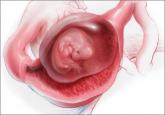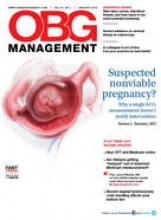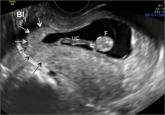It was refreshing to read Dr. Barbieri’srecent editorial on the management of ectopic pregnancies based on human chorionic gonadotropin (hCG) levels. However, I feel there’s an elephant in the room. The phrase “abnormal rise” is not clearly defined, even though countless texts and review articles continue to use the phrase. In fact, many authors include a flow chart in which an abnormal rise usually is followed by a recommendation to empty the uterus in an attempt to find chorionic villi.1,2 The most recent versions of several widely used textbooks advocate this practice,3–5 and a current UpToDate article includes a flow chart suggesting that a “suboptimal rise” is sufficient for diagnosis of an abnormal pregnancy requiring treatment.6
Kadar and colleagues originally suggested that 85% of viable intrauterine pregnancies (IUPs) will have a rise in hCG levels of at least 66% every 48 hours, leading to what is commonly called the “doubling rule.”7 Barnhart and colleagues showed that the slowest recorded hCG rise for a viable pregnancy in 48 hours was 53%, demonstrating that the hCG level does not double in 48 to 72 hours as traditionally expected.8 In their final model, the authors calculated that 99% percent of normal IUPs should have an increase of at least 53% in 2 days, moving the bar for a “normal” hCG rise even lower. This also implies that 1% of viable IUPs may have a rise of less than 53% over 2 days. I have to wonder how many viable, wanted pregnancies have been interrupted by the misguided use of discriminatory zones or abnormal rises resulting in the emptying of the pregnant uterus?
Clinical assessment and ultrasonography should continue to be the mainstay of management of ectopic pregnancy. When surgical diagnosis is needed, laparoscopy should be considered. In this day and age, when we are being more cautious about emptying a uterus based on ultrasound measurements of the fetus or gestational sac, why are we still so eager to base that decision on laboratory values? Are we really willing to accept that 1% of the time we will be terminating a viable pregnancy? We should stop the continued propagation of flow charts and strategies that use hCG discriminatory zones or abnormal rises to determine viability and when to evacuate the uterus. A contemporary update to address the issue is needed.
Devin Namaky, MD
Cincinnati, Ohio
References
1. Seeber B, Barnhart K. Suspected ectopic pregnancy. Obstet Gynecol. 2006;107(2):399–413.
2. Mukul LV, Teal SB. Current management of ectopic pregnancy. Obstet Gynecol Clin North Am. 2007;34(3):403–419.
3. Ectopic pregnancy. In: Hoffman BL, Schorge JP, Schaffer JI, et al, eds. Williams Gynecology. 2nd ed. New York, NY: McGraw-Hill Professional; 2012:198–218.
4. Lobo RA. Ectopic pregnancy. In: Lentz GM, ed. Comprehensive Gynecology. 6th ed. Philadelphia, PA: Elsevier Mosby; 2012:361–382 .
5. Damario MA, Rock JA. Ectopic pregnancy. In: Rock JA, Jones HW III, eds. Te Linde’s Operative Gynecology. 10th ed. Philadelphia, PA: Lippincott Williams & Wilkins; 2008:798–824.
6. Tulandi T. Ectopic pregnancy: clinical manifestations and diagnosis. UpToDate Web site. http://www.uptodate.com/contents/ectopic-pregnancy-clinical-manifestations-and-diag nosis. Updated October 22, 2014. Accessed February 18, 2015.
7. Kadar N, Caldwell BV, Romera R. A method of screening for ectopic pregnancy and its indications. Obstet Gynecol. 1981;58(2):162–166.
8. Barnhart KT, Sammel MD, Rinaudo PF, Zhou L, Hummel AC, Guo W. Symptomatic patients with an early viable intrauterine pregnancy: hCG curves redefined. Obstet Gynecol. 2004;104(1):50–55.
I read with attention Dr. Barbieri’s recent editorial about evaluation of early pregnancy. My question is: Why is serum progesterone not recommended or used to assess the health of an early pregnancy?
In my practice, I always use a serum progesterone test along with hCG measurements to ascertain if an early pregnancy is healthy. I have observed, as biased as this observation can be, as I have not done any study about it, that a serum progesterone level above 12 ng/dL correlates quite well with a healthy pregnancy. I only follow more intensively with serial ultrasonography and hCG measurements in a patient whose progesterone level is below 11 ng/dL.
When a patient’s only symptom is bleeding, if the serum progesterone level is below 11 ng/dL, and her serum quantitative hCG level does not double as appropriate, I consider the pregnancy not normal and counsel the patient about continuing observation or terminating the pregnancy.
In the same laboratory scenario but with a patient who has bleeding and pain, and even moreso if the progesterone level is below 8 ng/dL, I strongly consider an ectopic pregnancy until it is proven otherwise. In this case, I offer treatment with methotrexate, as it’s my experience that the vast majority of these patients are carrying an abnormal pregnancy— either a spontaneous abortion or an ectopic pregnancy. Methotrexate therapy will prevent further complications without causing the loss of normal pregnancies.




